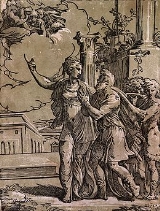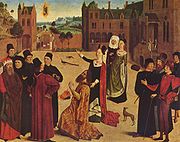
Tiburtine Sibyl
Encyclopedia

Ancient Rome
Ancient Rome was a thriving civilization that grew on the Italian Peninsula as early as the 8th century BC. Located along the Mediterranean Sea and centered on the city of Rome, it expanded to one of the largest empires in the ancient world....
sibyl
Sibyl
The word Sibyl comes from the Greek word σίβυλλα sibylla, meaning prophetess. The earliest oracular seeresses known as the sibyls of antiquity, "who admittedly are known only through legend" prophesied at certain holy sites, under the divine influence of a deity, originally— at Delphi and...
, whose seat was the ancient Etruscan
Etruscan civilization
Etruscan civilization is the modern English name given to a civilization of ancient Italy in the area corresponding roughly to Tuscany. The ancient Romans called its creators the Tusci or Etrusci...
town of Tibur (modern Tivoli
Tivoli, Italy
Tivoli , the classical Tibur, is an ancient Italian town in Lazio, about 30 km east-north-east of Rome, at the falls of the Aniene river where it issues from the Sabine hills...
).
The mythic meeting of Cæsar Augustus with the Sibyl, of whom he inquired whether he should be worshiped as a god, was a favored motif of Christian artists. Whether the sibyl in question was the Etruscan Sibyl
Etruscan Sibyl
The Etruscan Sibyl was the priestess presiding over the Apollonian oracle. The word Sibyl comes from the ancient Greek word sibylla, meaning prophetess. There were many Sibyls in the ancient world, but the Etruscan Sibyl predicted the Trojan War.Whether the sibyl in question was the Tiburtine...
of Tibur or the Greek Sibyl
Cumaean Sibyl
The ageless Cumaean Sibyl was the priestess presiding over the Apollonian oracle at Cumae, a Greek colony located near Naples, Italy.The word sibyl comes from the ancient Greek word sibylla, meaning prophetess. There were many Sibyls in different locations throughout the ancient world...
of Cumæ is not always clear. The Christian author Lactantius
Lactantius
Lucius Caecilius Firmianus Lactantius was an early Christian author who became an advisor to the first Christian Roman emperor, Constantine I, guiding his religious policy as it developed, and tutor to his son.-Biography:...
identified the sibyl in question as the Tiburtine sibyl. He gave a circumstantial account of the pagan sibyls that is useful mostly as a guide to their identifications, as seen by 4th century Christians:
-
- (Divine Institutes I.vi)
The prophecy of the Emperor Constans
An apocalyptic pseudo-prophecy exists among the Sibylline OraclesSibylline oracles
The Sibylline Oracles are a collection of oracular utterances written in Greek hexameters ascribed to the Sibyls, prophetesses who uttered divine revelations in a frenzied state. Fourteen books and eight fragments of Sibylline Oracles survive...
, attributed to the Tiburtine Sibyl, written c. 380 CE, but with revisions and interpolations added at later dates. It purports to prophesy the advent in the world's ninth age of a final Emperor vanquishing the foes of Christianity:
This Emperor's reign is characterized by great wealth, victory over the foes of Christianity, an end of paganism and the conversion of the Jews. The Emperor having vanquished Gog and Magog
Gog and Magog
Gog and Magog are names that appear primarily in various Jewish, Christian and Muslim scriptures, as well as numerous subsequent references in other works. Their context can be either genealogical or eschatological and apocalyptic, as in Ezekiel and Revelation...
,
In doing so, he will give way to the Antichrist
Antichrist
The term or title antichrist, in Christian theology, refers to a leader who fulfills Biblical prophecies concerning an adversary of Christ, while resembling him in a deceptive manner...
:
The prophecy relates that Antichrist would be opposed by the Two Witnesses
Two Witnesses
The two witnesses are two of God's prophets who are seen in a vision by John of Patmos, who appear during the Second woe in the Book of Revelation 11:1-14....
from the Book of Revelation
Book of Revelation
The Book of Revelation is the final book of the New Testament. The title came into usage from the first word of the book in Koine Greek: apokalupsis, meaning "unveiling" or "revelation"...
, identified with Elijah and Enoch
Enoch (ancestor of Noah)
Enoch is a figure in the Generations of Adam. Enoch is described as Adam's greatx4 grandson , the son of Jared, the father of Methuselah, and the great-grandfather of Noah...
; after having killed the witnesses and started a final persecution of the Christians,
Frescoes at the Villa d'Este
Ippolito II d'EsteIppolito II d'Este
Ippolito d'Este was an Italian cardinal and statesman. He was a member of the House of Este, and nephew of the other Ippolito d'Este, also a cardinal.-Biography:...
rebuilt the Villa d'Este
Villa d'Este
The Villa d'Este is a villa situated at Tivoli, near Rome, Italy. Listed as a UNESCO world heritage site, it is a fine example of Renaissance architecture and the Italian Renaissance garden.-History:...
at Tibur, the modern Tivoli
Tivoli, Italy
Tivoli , the classical Tibur, is an ancient Italian town in Lazio, about 30 km east-north-east of Rome, at the falls of the Aniene river where it issues from the Sabine hills...
, from 1550 onward, and commissioned elaborate fresco murals in the Villa that celebrate the Tiburtine Sibyl, as prophesying the birth of Christ to the classical world.
Gallery
File:Antonio da Trento - The Tiburtine sibyl and the Emperor Augustus.jpg|The Tiburtine sibyl and the Emperor Augustus, a 16th-century chiaroscuro woodcut by Antonio da Trento
Antonio da Trento
Antonio da Trento was an Italian engraver.Da Trento was born in Trento. He specialized in chiaroscuro wood carving, especially of religious themes and scenes . Da Trento probably first learned wood engraving from Ugo da Carpi...
Image:TiburtineSibylMontfoort.jpg|Engraving of the Tiburtine Sibyl by Philip Galle, after a design by Antony van Blokland
Anthonie van Montfoort
Anthonie Blocklandt van Montfoort, Anthonie van Blocklandt or Anthonie van Montfoort was a Dutch painter-Life:...
, Antwerp, 1575.
File:Antoine Caron - Augustus and the Sibyl - WGA4276.jpg|Augustus and the Sibyl, by Antoine Caron
Antoine Caron
Antoine Caron was a French master glassmaker, illustrator, Northern Mannerist painter and a product of the School of Fontainebleau.He is one of the few French painters of his time who had a pronounced artistic personality...
, Louvre Museum
File: Sibilla Tiburtina Cappella Marciac Roma curavit Roberto Borgia 2011.jpg | The Tiburtine Sibyl , Chapel Marciac, Church of Santissima Trinità dei Monti, Rome, sixteenth century. The work is of an anonymous
File:Amedeo_Brogli_Sibilla_Tiburtina_(The_Tiburtine_Sibyl)_2005.jpg | The Tiburtine Sibyl, by Amedeo Brogli, 2005,private collection.
External links
- The Pseudo-Tiburtine prophecy, dated ca 380, with additions (e-text)

